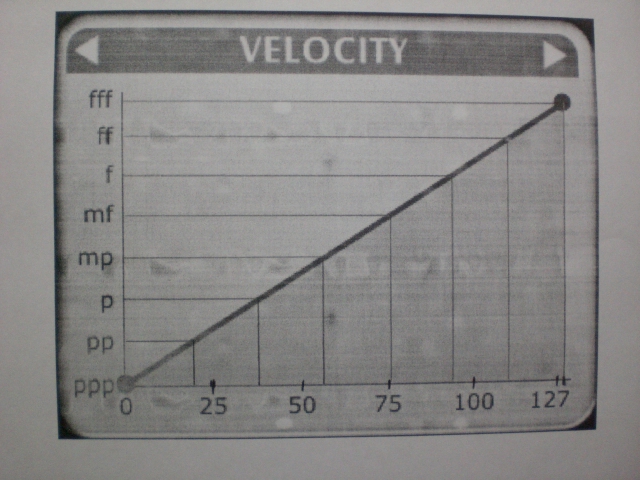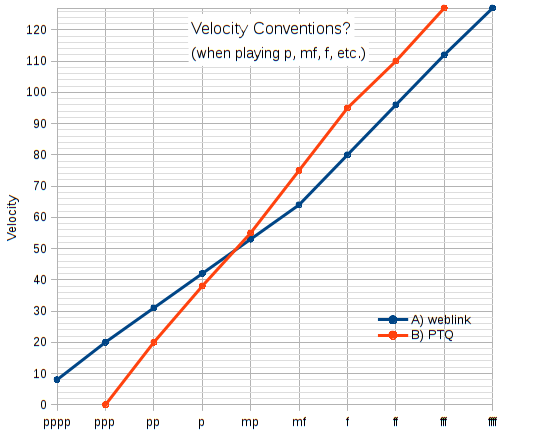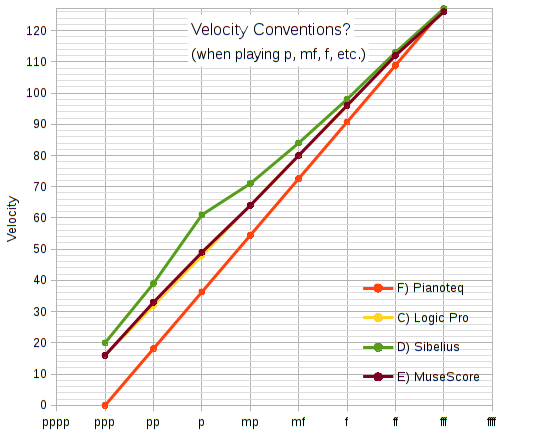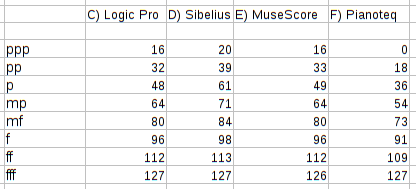Topic: pppp to ffff
I saw the following table on the linked site:

Is this a common MIDI convention? does one exist? Or is it just arbitrary?
I saw the following table on the linked site:

Is this a common MIDI convention? does one exist? Or is it just arbitrary?
It will be interesting to see people's thoughts on this. The scale that you show is not too far away from one that I figured out from Pianoteq's velocity display (except that I started at ppp and went to fff, using ranges rather than fixed values). Here's what I came up with:
ppp: up to 16
pp: 16-32
p: 32-48
mp: 48-64
mf: 64-80
f: 80-96
ff: 96-112
fff: 112-127
Dynamics are open to interpretation to some extent. For example, at what point does pp become 'officially' p? Do feel free to disagree with the values in my list, it's just my working reference for velocity testing.
Living Pianos:
How Loud is Fortississimo FFFF? How Quiet is PPPP?
https://www.youtube.com/watch?v=u068WWVDbCI
Thank you, Don,
nice find! - It just has nothing to do with MIDI.
Having no time to write a text at the moment, so I just post the pictures (hopefully self-explanatory):


Hi groovy, interesting numbers and question.
Shortest answer I think = arbitrary.
I think of the 8 points from 'ppp' to 'fff' (3 letters) in the Pianoteq interface are just common convention.
A performed dynamic can be marked arbitrarily - but translating for MIDI in turn will certainly also mean we'd each arbitrarily calibrate for intended effect in kind.
I think of the 8 points from 'ppp' to 'fff' (3 letters) in the Pianoteq interface are just common convention.
Yes, 8 "landmarks" for 7 performable dynamic ranges are used by other music-softwares, found here:
https://en.wikipedia.org/wiki/Dynamics_(music)
The easiest convention seems to be the one, that Pianoteq is using: 7 equidistant dynamic ranges represented linearly by 0-127 velocity values (orange line, now calculated):


Using another convention could have unwanted implications. A piano=p played keyboard in Pianoteq's convention is represented by a MIDI value 36, while other softwares are "thinking" that higher values, like 48 (Logic Pro) or 61 (Sibelius) represent a p-played keyboard.
More complicated it gets, when keyboard-builders do not follow the conventional range of 0 - 127. For example not a few keyboards (Kawai, Yamaha, ...) have a shallow range of 25 - 105, which represents it being played ppp - ("pounding")fff.
No wonder, that every virtual instrument needs an individual, thoroughly customized velocity curve for every individual MIDI keyboard. Not enough standardisation here.
Thanks groovy, love that Wikipedia page's mention of the historical uses of fffff and other extreme marks - there's surely a Spinal Tap fffffffffff joke in this ("These go to 11") but I won't go there, he said, after having gone there
Interesting to see Sibelius place the p so high. Pianoteq's lower numbers definitely seem most rational to me (maybe mostly mf at 73 rather than 80 or 84).
On standardisation, I'm hopeful VST and keyboard manufacturers might be able to use upcoming MIDI 2 specs to improve things. Don't know if that would amount to better standardisation per se or just better options and greater depths of realism for any plugged in keyboard - fingers crossed either way.